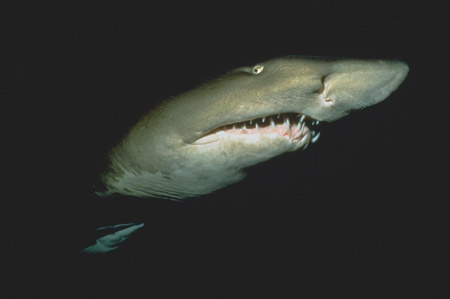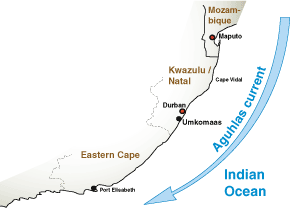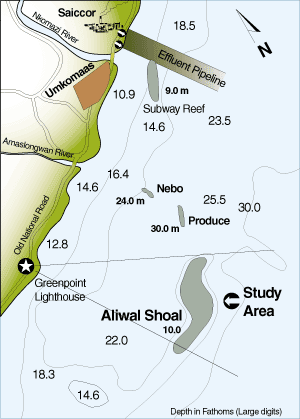
|
|
|
|
|
|
Shark Info (03-15-2000) |
Author |
|
Intro: |
Shark Info |
|
Main article: |
Andrew Cobb |
|
Article 1: |
Prof. H. Greven |
|
Article 2: |
Prof. M. S. Shivji |
|
Fact Sheet: |
Dr. E. K. Ritter |
|
The hard battle continues to preserve Aliwal Shoal - a paradise for sand tiger sharks
Fifty kilometers south of Durban, off the coast of KwaZulu in Natal, South Africa, lies the small town of Umkomaas which is the starting point for a fascinating voyage to the sand tiger sharks (Carcharias taurus) on the Aliwal Shoal. The origin of Aliwal ShoalThe Aliwal Shoal was formed 80'000 years ago from a sand dune. It all began with the shifting of the continental plates which caused a rise in the sea level of the Indian Ocean and hence flooding of the dune. In the thousands of years that followed the deposit of seashells and other reef-building materials led to the welding of a massive sandstone core. Today, Aliwal Shoal is the home of many different species of fish and other living marine organisms, including sea turtles, dolphins and humpback whales, as well as the famous sand tiger sharks which the local South African population affectionately calls "raggies" (Editor's Note: "Raggie" is an abbreviation for ragged-tooth shark, one of the English names of the sand tiger shark). Migration routes of sand tiger sharks
Sand tiger sharks undertake annual migrations in South African waters, spending the time between June and end of November in the Aliwal Shoal. In late November they leave the region and swim approximately 300 km north to Cape Vidal where they mate. The pregnant females then swim northwards towards the Mozambique coast while the males swim to another unknown location. At some point the females then ride the Agulhas current (see map) back south where they bear their young off the coast of Port Elisabeth and Plettenberg Bay approximately 9 months later, completing the cycle and followed by recommencement of the migrations. The Natal Shark Board intervenesNot even 20 years have passed since the first divers dared to swim in these waters despite shark warnings from the local population. I belonged to this first group of divers and must admit that, at that time, even I expected to experience "Jaws" in person. But contrary to our fears no incidents occurred with these animals. I was a police diver then, and after the dives I would report on sand tiger sharks and their behavior at our monthly group meetings. Graham Carter, deputy director of the Natal Shark Board (NSB), was also in this group at the time. (Editor's Note: The NSB is a semiprivate institute established for the purpose of answering questions on shark problems). Up until then the NSB had already investigated sand tiger sharks, but the Aliwal Shoal with its sand tiger sharks was still unknown to them. In 1994 the decision was thus made to instruct a group of diving teachers and have them collect data for the NSB. Environmental Pollution
The Aliwal Shoal is a paradise for many species, not only for sand tiger sharks, but its preservation initially had to be fought for and the fight is far from over. The Aliwal Shoal region, including the entire southern coast of Natals, was threatened with destruction due to environmental pollution in the early phase of our research. The main problem was the SAICCOR cellulose (dissolving) plant in Umkomaas which dumped its entire untreated effluent into the ocean. The suspended matter reduced visibility to less than one meter and the foam made entire beaches unusable. Even the periodical widespread dying-off of freshwater and ocean fish was not unusual. A solution had to be found. In 1994 public anger at pollution on the coast of Natals found an outlet after the change in government and a newly elected Minister of the Environment who was sympathic to the cause. This resulted in the establishment of the "South Coast Marine Pipeline Forum (SCMPLF)" which was unique in South Africa's history because it gathered all affected parties at one table, not only representatives from public authorities and industry. Transparency was required, and for the first time the public was represented in such a forum. This is astonishing considering that under the former government the subject of effluent emissions stemming from factories was treated behind closed doors. The Pipeline Forum commissioned social and environmental studies. A study on the social aspect of environmental pollution compiled by the Geographical Institute of the University of Natal clearly showed that the value of having clean coasts is considerably more important than optimizing profits of the affected industries. After all, the owners of the three largest ocean pipelines had to pay the city of Natal millions of rands (several hundred thousand dollars) to clean the ocean and the coasts. SAICCOR, the cellulose plant in Umkomaas, had to extend their pipeline from 3 to 6 km and was forced to construct a special water treatment plant to remove at least 50,000 of the total yearly 460,000 tons of lignosulfates, a byproduct of cellulose production, from the effluent. These measures, especially the pipeline extension, were effective very quickly. Umkomaas' beaches are again free of foam, the sea is blue and even in Aliwal water visibility has considerably improved. However, it would be foolish to give an "all clear" signal because 410,000 tons of lignosulphonate are still pumped untreated directly into the ocean. Political ConfusionIn many of my lectures I pointed to the problem in Aliwal Shoal and managed to motivate a group of people with the same viewpoint to form the "Aliwal Rescue Action Group". This group was very active and beginning 1994 was granted a hearing with the responsible government offices. Both the African Minister of the Environment and the Director of the Marine Fishing Authorities agreed that this region must be protected. Unfortunately, in 1994 there was a change in government and the Minister of the Environment was replaced. This meant the end of the initiative and the need to search for a new solution. We agreed that an underwater park had be established which would simultaneously cover all of the different fields of interest. I took these plans to the South African Tourism Authorities whereupon a workshop was organized to deal with the problem. A respective initiative has since been caught up in beaurocratic red tape. Although the initiative has still not been approved, the change in government definitely also had its positive side. The new Minister of the Environment, Professor Kadar Asmal, helped the Department of Water Affairs, among others, to assume a new more plausible position, a prerequisite for the success of the South Coast Pipeline Forum. Diving tourism poses new threatThanks to all the improvements in water quality, diving with the sand tiger sharks in the reefs of Aliwal Shoal has again become very attractive. Unfortunately, this was too quickly recognized by greedy diving businesses. On busy weekends 20 boats can be found directly on the Aliwal Shoal, and some of the divers are even equipped with spears. It is now a race against time until this region receives the necessary protection, for the continual invasion into the resting areas of the sand tiger sharks will sooner or later chase them away. Our objectiveThe opportunity to dive in harmony with the ocean and its inhabitants, the sand tiger sharks, is an absolutely fascinating experience. By literally becoming a part of their world, one can study their natural behavior and interact with them undisturbed in their natural environment. However, later generations will be robbed of this privilege unless we demand additional measures to protect the Aliwal Shoal from pollution and from excessive diving tourism. We must protect Aliwal for the sand tiger sharks and for mankind. And we have no time to simply be content with our previous achievements, instead we must continue to fight for the protection of this unique marine region before it literally disappears before our eyes. * Andrew C. R. Cobb is a leading personality when it comes to shark protection in the KwaZulu region and South Africa. He was the first shark diving teacher and guide officially accredited by the South African Tourism Authorities. May be published only by indicating the source: Shark Info / Andrew C. R. Cobb |
|
|
|
|
|
|||||


